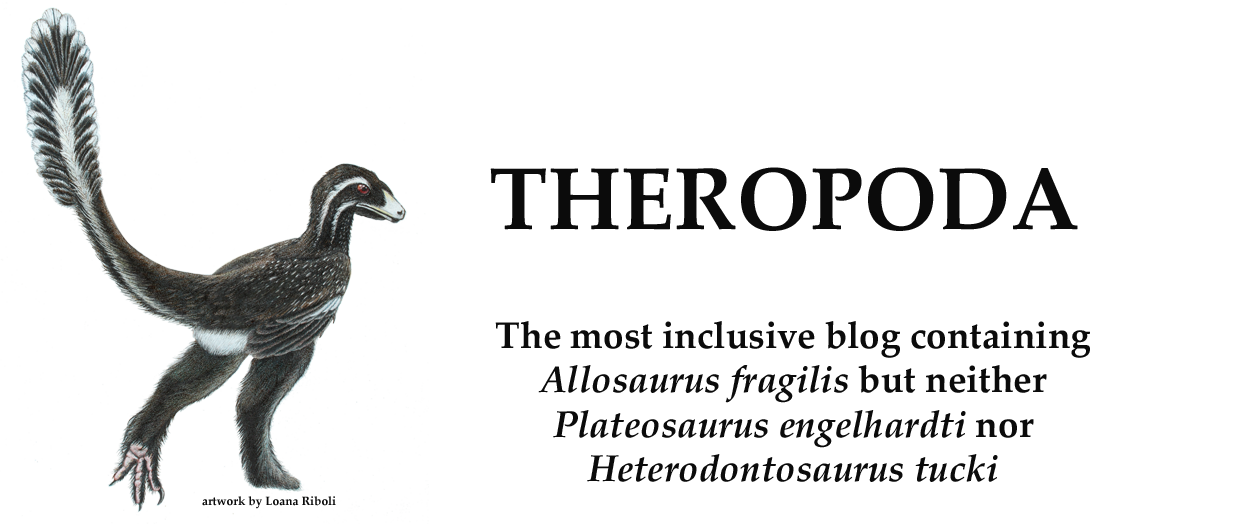Brusatte et al. (2016) descrivono un neurocranio di theropode dal Cenomaniano-Turoniano dell'Uzbekistan caratterizzato da una unica ed inusuale combinazione di caratteri, ed istituiscono Timurlengia euotica. Gli autori inoltre riferiscono provvisoriamente a Timurlengia tutti i resti isolati di tyrannosauroide di dimensioni paragonabili a quelle dell'animale stimato dal neurocranio e provenienti dalla medesima formazione. Io ho espresso in passato dubbi su certe attribuzioni di resti isolati non-sovrapponibili sulla base della provenienza, ed anche se condivido la plausibilità di tale attribuzione preferisco provvisoriamente restringere il nome T. eutotica al solo neurocranio. In ogni caso, tra il materiale riferito è interessante la presenza di un mascellare allungato che ricorda in parte Xiongguanlong (di età lievemente più antica).
Non ho ancora incluso Timurlengia (l'olotipo) in Megamatrice, ma condivido l'ipotesi degli autori che questo neurocranio appartenga ad un Tyrannosauroidea più prossimo ai "veri tyrannosauridi" del Cretacico Superiore rispetto alle forme più basali (come i Proceratosauridae). Da notare che anche Xiongguanlong risulta nella medesima "zona" di Tyrannosauroidea, un "grado intermedio" se usiamo Tyrannosauridae come "forme derivate".
Brusatte et al. (2016) concludono con questa osservazione molto interessante:
We hypothesize that these two taxa, and, potentially,
a long-snouted skull from the Bayan Shireh Formation previously
assigned to Alectrosaurus [...], belong to a
grade or clade of longirostrine tyrannosauroids immediately outside
of the clade of derived, large-bodied, latest Cretaceous forms. This
midsized, long-snouted bauplan may have been the ancestral stock
from which the gigantic tyrannosaurids arose. (Brusatte et al. 2016: 5)
Non cogliete il senso della affermazione?
Gli autori, sulla base della distribuzione dei caratteri emersa dalla loro analisi dei Tyrannosauroidea, concludono che dobbiamo aspettarci di trovare dei tyrannosauroidi di media-dimensione, caratterizzati da musi allungati, nell'intervallo Aptiano-Turoniano, e filogeneticamente intermedi tra Proceratosauridae e Tyrannosauridae.
Ma questi, sono proprio i Megaraptoridae per chi (come me) li colloca in Tyrannosauroidea!
Bibliografia:
Stephen L. Brusatte, Alexander Averianov, Hans-Dieter Sues, Amy Muir and Ian B. Butler (2016). New tyrannosaur from the mid-Cretaceous of Uzbekistan clarifies evolution of giant body sizes and advanced senses in tyrant dinosaurs. Proceedings of the National Academy of Sciences of the United States of America. www.pnas.org/cgi/doi/10.1073/pnas.1600140113


Me piache molto el título "...y el fantasma de los Megaraptoridae"!!! Gracias Andrea por tener presente esta idea nuestra acerca de la ubicación de los megaraptoridos dentro de Coelurosauria.
RispondiEliminaI work on the fauna of the Cretaceous landmass of Appalachia and I find this post very relevant to a theory I've been writing about in my book. The tyrannosauroids of Appalachia (specifically Dryptosaurus aquilunguis, although Appalachiosaurus may fall into a clade with the D. aquilunguis) seem to have evolved in isolation, as possible tyrannosauroid remains are known from an Appalachian deposit known as the Woodbine Formation which formed right after the formation of the Western Interior Seaway. We also have evidence for a potentially large tyrannosauroid or tyrannosauroid relative from the latest Cenomanian-Turonian of New Jersey in the form of an almost completely destroyed trackway (only one footprint remains and is on display at Rutgers University) and a partial pedal element which comes from a "dinosaur similar to Albertosaurus"(for more information, see William Gallagher's 1997 book The Dinosaurs of New Jersey). If the megaraptorids were indeed tyrannosauroids, my theory is that we might have convergence between branches of the tyrant dinosaur family tree over the last 30 million years of the Cretaceous. This convergence would be in the form of large manal claws (albeit pertaining to forelimbs with different morphologies- I refer to the small arms and large hands of Dryptosaurus vs. the overall large arms of megaraptorids in comparison to other tyrant dinosaurs) as well as in a less massive skull. I was curious as to what you'd think of this theory of mine. Cheers & great post!
RispondiEliminaChase